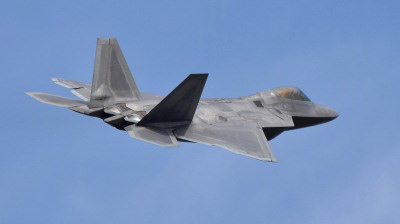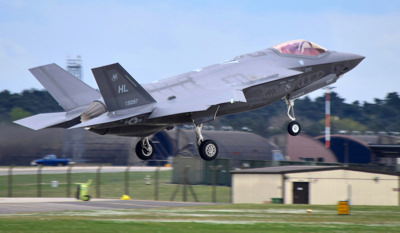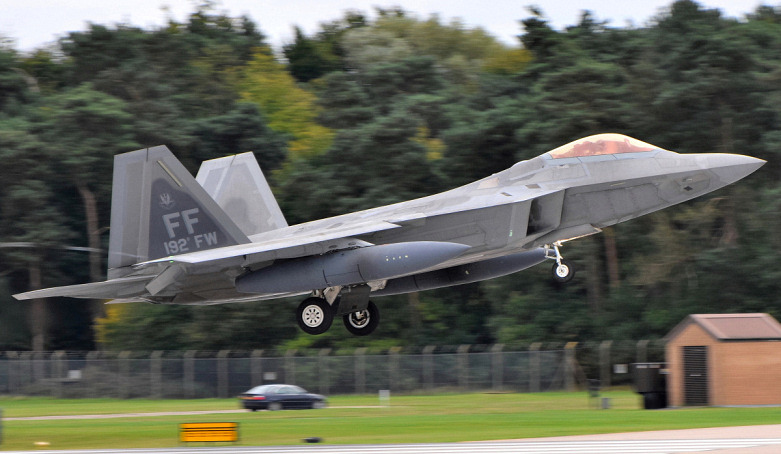RAF Lakenheath is located north-west of Bury St Edmunds in Suffolk, and hosts United States Air Force units and personnel. The host wing is the 48th Fighter Wing (48 FW), also known as the 'Liberty Wing', which includes two Squadrons of F-15E Strike Eagles and two Squadrons of F-35A Lightning II aircraft.
RAF Lakenheath will eventually receive all fifty four F-35A Lightning II aircraft which will equip the 493rd and 495th Fighter Squadrons. They also operate two Squadrons of F-15E Strike Eagles (492nd & 494th Fighter Squadrons).
RAF Lakenheath Satellite View
Military Aircraft Tracker in the UK
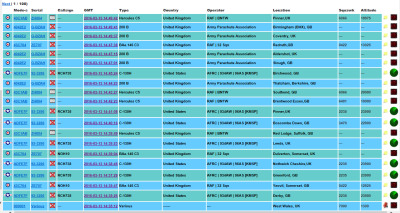 • Current Military Aircraft in the UK Tracker.
• Current Military Aircraft in the UK Tracker.
• Historic Military Aircraft in the UK Tracker.
• Military Aircraft around the World Tracker.
Live Trackers
When using ADS-B Exchange Tracker then click on 'U' to see military aircraft.
Scanner Frequencies
RAF Lakenheath Scanner Frequencies:
Approach - 128.900, 136.500, 275.825
Departures - 264.575
Arrivals - 256.425, 279.050, 296.675
Dispatch - 378.150
Tower - 373.775, 122.100(NATO)
Ground - 397.350
ATIS - 341.040
|
Military Aircraft Photographs at UK Military Bases
Aircraft & Squadrons
RAF Lakenheath is home to the United States Air Force (USAF) 48th Fighter Wing (Liberty Wing) which consists of 492nd Fighter Squadron with the F-15E Strike Eagle, 493rd Fighter Squadron with the F-35A Lightning II, 494th Fighter Squadron with the F-15E Strike Eagle, and 495th Fighter Squadron with the F-35A Lightning II.
493rd Fighter Squadron previously operated the F-15C/D Eagle aircraft at Lakenheath but these aircraft are currently being replaced with the F-35A Lightning II.
The F-15E Strike Eagle is an all-weather, multirole, two-seat, twin-engine strike fighter. It can be distinguished from other U.S. Eagle variants by darker aircraft camouflage and conformal fuel tanks mounted along the engine intake ramps. The F-15C Eagle is an all-weather single-seat tactical fighter designed for air supremacy in aerial combat and the F-15D Eagle is a two-seat training version. The F-35A Lightning II is a fifth generation, single-seat, single-engine, all-weather, stealth, multirole combat aircraft that is intended to perform both air superiority and strike missions.
The 48th Operations Group provides equipment, training, scheduling, analysis, weather, intelligence, standardisation and evaluation, and command and control for efficient flying operations. The 48th Maintenance Group is responsible for all organisational and intermediate level maintenance for the aircraft, munitions and support equipment. The 48th Medical Group offers primary and specialty health care services and the 48th Mission Support Group executes expeditionary and in-garrison personnel, logistics, communications, contracting, engineering and services support.
To accommodate the new F-35A Lightning II aircraft, which began to arrive at Lakenheath on the 15th December 2021, a Campus was constructed on the south side of the airfield. The 48th Fighter Wing announced that 495th Fighter Squadron (a former F-111 Sqn) was to be reactivated as an F-35A Lightning II unit (the Valkyries) at RAF Lakenheath. 493rd Fighter Squadron, which previously operated the F-15C/D Eagle at Lakenheath started to be equipped with the F-35A Lightning II on 15th December 2021.
More details about the arrival of F-35A Lightning II aircraft at RAF Lakenheath can be found
here.
• 492nd FS (Madhatters) - F-15E Strike Eagle.
• 493rd FS (Grim Reapers) - F-35A Lightning II.
• 494th FS (Panthers) - F-15E Strike Eagle.
• 495th FS (Valkyries) - F-35A Lightning II.
History
Lakenheath Warren was a Royal Flying Corps (RFC) airfield in WW1 and was used as a bombing and ground-attack range for aircraft operating from other airfields. It was abandoned in 1918 after the War.
During WW2, in 1940, Lakenheath was used as a decoy airfield and false lights, runways, and aircraft were used to help divert attacking German aircraft away from RAF Mildenhall. In 1941, hard runways were layed along with taxiways, hardstands for 36 aircraft, and the building of hangars. Lakenheath was used by RAF flying units on detachment and served as a satellite of RAF Mildenhall. Lakenheath operated Vickers Wellingtons and Short Stirling bombers. In 1943, more hangars were built for glider storage, housing 40 Horsa Gliders.
In 1945, Lakenheath was selected to be upgraded to a Very Heavy Bomber airfield operating the United States Army Air Forces Boeing B-29 Superfortresses. The existing runways were removed and new longer ones layed using 12 inches of high-grade concrete. The War ended by the time that the work was finished and RAF Lakenheath was put on a care and maintenance status. In April 1947, RAF Bomber Command returned to Lakenheath and had the runways repaired, resurfaced, and readied for operations by May 1948.
Operational control of RAF Lakenheath was transferred from the RAF to United States Air Force Europe (USAFE) at the end of 1948. The first host unit was the 7504th Base Completion Squadron which was elevated to Air Base Group (ABG) in 1950, and then to a Wing. Lakenheath became one of three main operating bases for the U.S. Strategic Air Command in the UK operating the B-29 Superfortress, and then the B-50 Superfortress and the B-47 Stratojet in 1954.
In 1959, French president Charles de Gaulle insisted that non-French nuclear capable forces should be withdrawn from France so the USAF redeployed its North American F-100 aircraft. The 48th TFW left Chaumont AB, France in 1960 and arrived at Lakenheath. RAF Lakenheath was transferred from Strategic Air Command back to USAFE. The tactical components of the 48th TFW upon arrival at Lakenheath were the 492nd, 493rd & 494th Tactical Fighter Squadrons.
The 48th TFW (Tactical Fighter Wing) operated the North American F-100 and then the F-4D Phantom II before operating the General Dynamics F-111F in 1977. Lakenheath's F-111s from the 48th TFW participated in the United States bombing of Libya in 1986. With the departure of the F-111, Lakenheath received its first McDonnell Douglas F-15E Strike Eagles in 1992. 493rd Squadron was reactivated with the F-15C/D which made the 48th TFW the largest F-15E/F-15C composite unit in the U.S. Air Force.

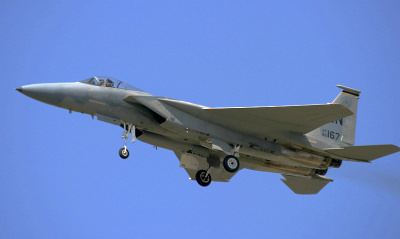
 F-15C Eagle.
F-15C Eagle.
 USAF F-35A Lightning II.
USAF F-35A Lightning II.
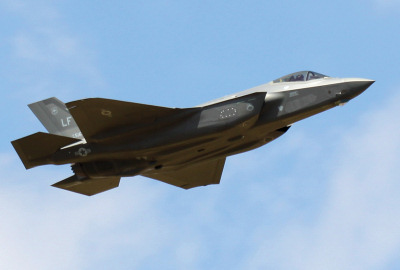 USAF F-35A Lightning II..
USAF F-35A Lightning II..

